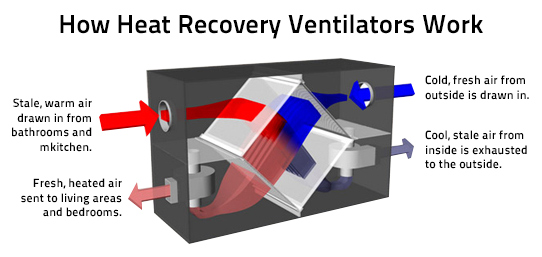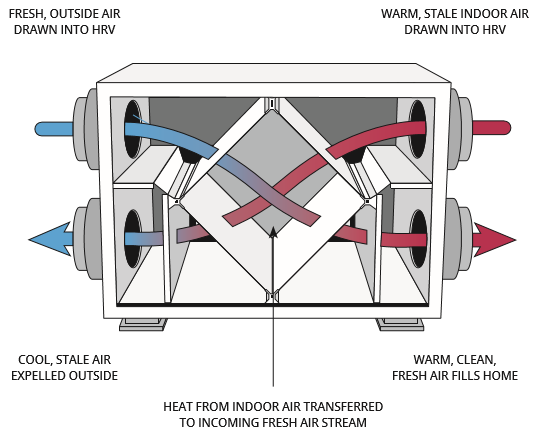Checking out the Benefits of Heat Recovery Ventilation for Power Performance in Residences
Heat Recovery Ventilation (HRV) systems use property owners a practical technique to enhancing energy performance. By reclaiming heat from outbound air, these systems can substantially decrease heating & cooling costs. Furthermore, they offer a stable supply of fresh air, enhancing indoor air quality and convenience degrees. As property owners take into consideration lasting options, comprehending the nuances of HRV systems becomes increasingly essential. What factors should one assess before making such an investment?
Understanding Heat Recovery Ventilation Equipments

Exactly How HRV Boosts Indoor Air High Quality

Energy Financial Savings: The Financial Advantages of HRV
Taking full advantage of energy performance, heat recovery ventilation (HRV) systems supply significant monetary advantages for homeowners. By recovering and recycling warmth from exhaust air, HRVs noticeably reduce heating & cooling prices. This innovation can lead to power cost savings of up to 30%, relying on climate and usage patterns. Homeowners usually discover decreased energy bills quickly after setup, making HRVs a financially wise financial investment in time. Furthermore, several regions give rewards or refunds for energy-efficient upgrades, better boosting the monetary allure. As power prices remain to increase, the cost-effectiveness of HRVs becomes increasingly clear. In general, the incorporation of HRV systems not only see this website promotes energy effectiveness but additionally adds to lasting economic savings for houses.
The Environmental Effect of Heat Recovery Ventilation
A substantial environmental advantage of heat recovery ventilation (HRV) systems hinges on their capacity to lower overall energy usage. By reclaiming warm from exhaust air and transferring it to incoming fresh air, HRV systems minimize the demand for energy-intensive home heating and cooling approaches. This reduction in power demand contributes to reduce greenhouse gas discharges, as less fossil gas is required to preserve comfortable interior temperature levels. Furthermore, HRV systems boost indoor air top quality by efficiently trading stagnant air with fresh outside air, minimizing dependence on mechanical cooling systems that can harm the atmosphere. Generally, the execution of HRV systems supports sustainable living practices and straightens with international initiatives to battle climate change by promoting energy effectiveness in property setups.
Picking the Right HRV System for Your Home
Just how can house owners guarantee they choose the appropriate heat recovery ventilation (HRV) system for their needs? They must assess their home's dimension and format, as these factors affect air movement needs. Next, reviewing the system's efficiency scores is vital, as higher ratings indicate much better performance and energy savings. Property owners should additionally take into consideration installment and maintenance expenses, contrasting different brands and designs for worth. Additionally, it is very important to review sound degrees, as some systems operate more silently than others. Consulting with a/c specialists can supply tailored recommendations based on specific home conditions. Finally, taking click site a look at individual reviews and service warranties can assist in making an informed choice, making certain that the picked HRV system properly improves interior air quality and energy performance.
Often Asked Inquiries

Exactly how Typically Should I Clean or Keep My HRV System?
The frequency of cleansing or preserving a heat healing air flow (HRV) system usually relies on usage and ecological elements. Typically, it is recommended to execute upkeep every six months to assure peak performance and air quality.

Can HRV Systems Assist Minimize Humidity Levels Inside Your Home?
HRV systems can successfully decrease interior humidity degrees by trading stale, humid air with fresh, drier look at this site air from outside. HRV Heat Recovery Ventilation. This procedure helps preserve a well balanced interior atmosphere, boosting comfort and preventing moisture-related concerns
What Is the Lifespan of a Typical HRV System?
The life expectancy of a regular heat recovery ventilation (HRV) system varies, typically lasting between 10 to 15 years. Normal upkeep can prolong its performance and functional life, ensuring peak efficiency throughout its usage duration.
Exist Any Sound Worry About HRV Equipments?
Noise worry about HRV systems can develop, especially from follower operation. Numerous modern-day devices are made to decrease audio degrees, ensuring they run silently while keeping efficiency, which resolves prospective disruptions in living environments.
Can I Mount an HRV System Myself, or Do I Need an Expert?
The specific contemplated whether to set up the heat recovery ventilation (HRV) system personally or employ an expert. Typically, while DIY setup is possible, proficiency guarantees correct performance and compliance with regional building ordinance, improving system effectiveness.